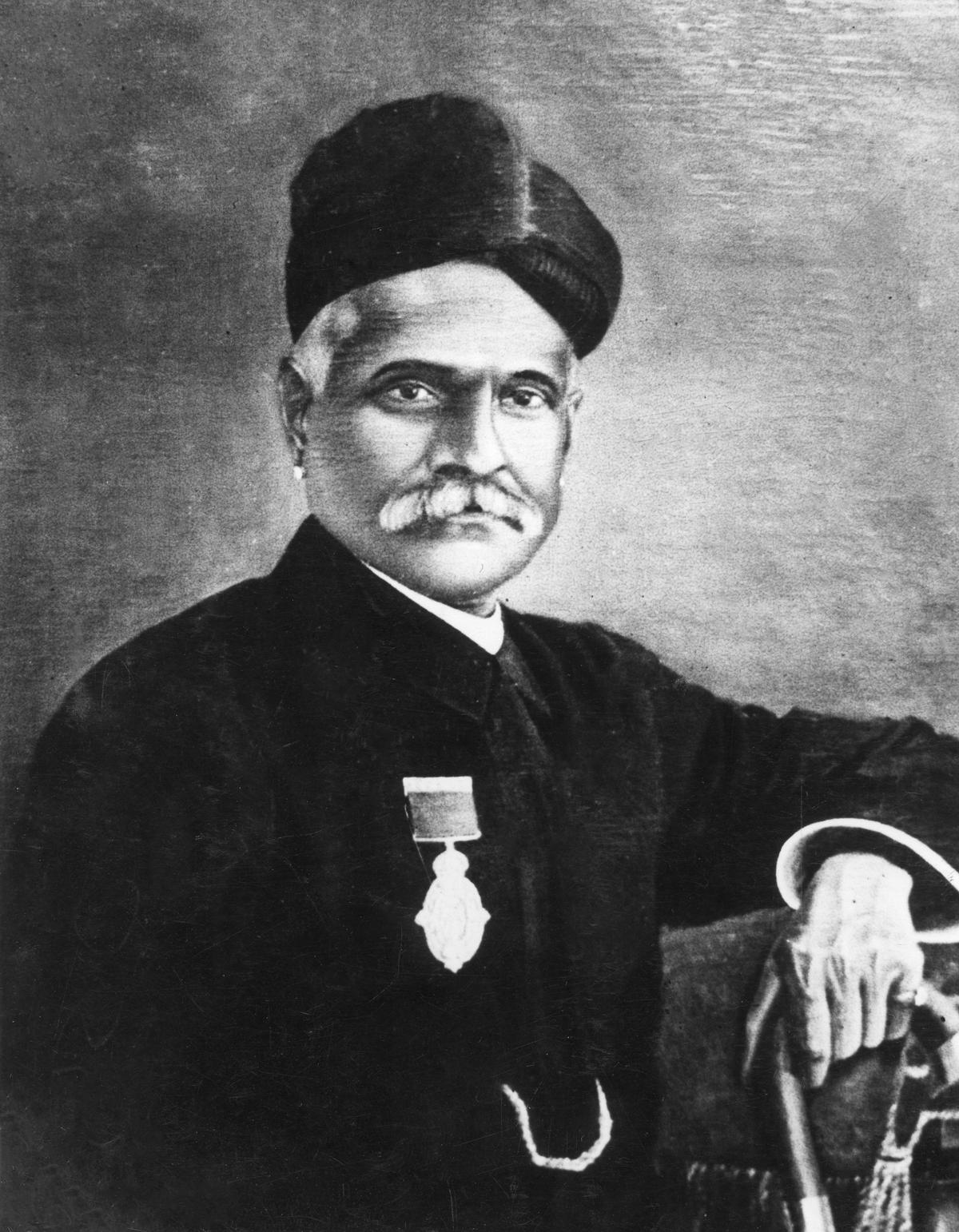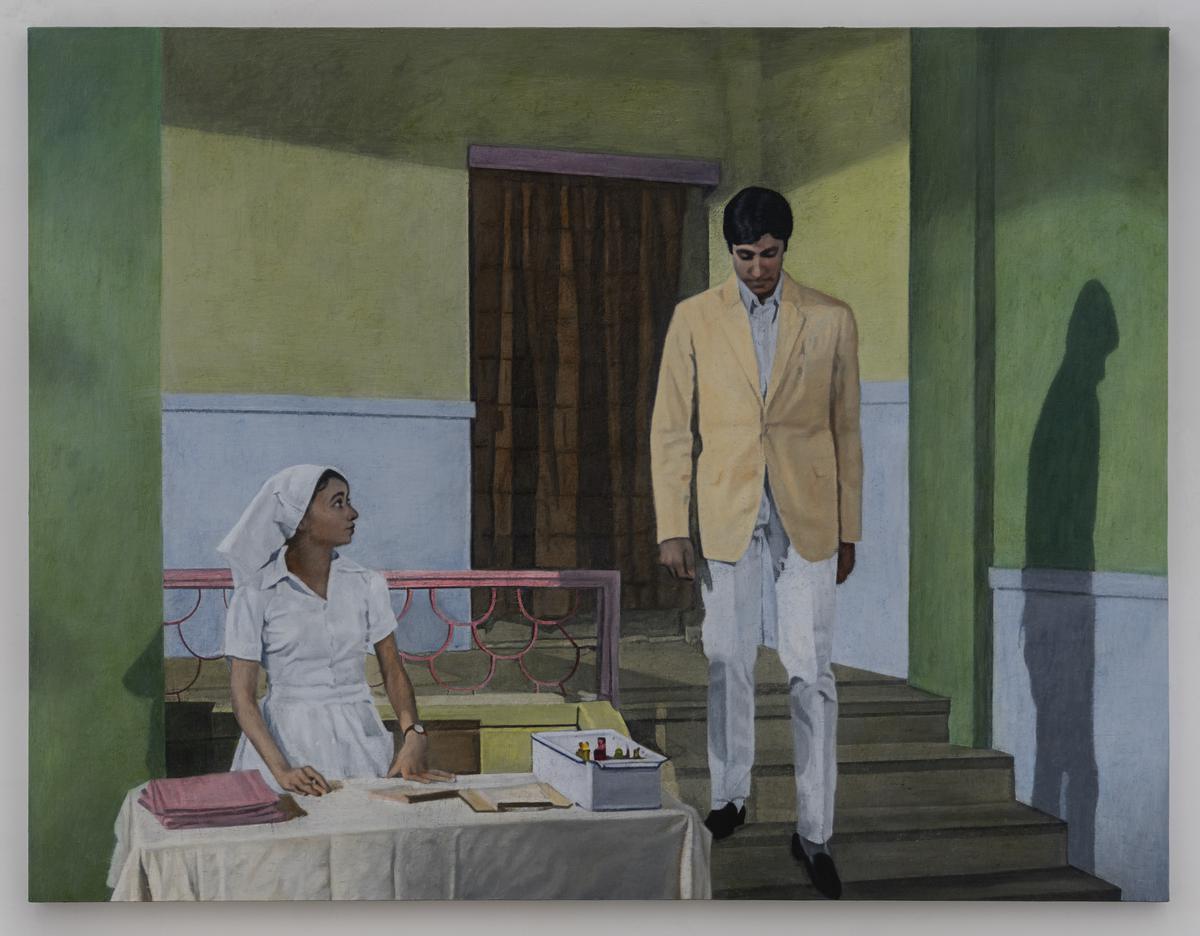
Modernist painter Raja Ravi Varma’s first commissioned painting, Kizhakke Palat Krishna Menon & Family
| Photo Credit: Delhi Art Gallery
At the intimate space of the Delhi Art Gallery (DAG), inside the Taj Mahal Palace Hotel in Colaba, a historic painting is under the spotlight. It is a family portrait by India’s first modernist painter, Raja Ravi Varma. The work, a horizontal oil-on-canvas, depicts a man, a woman and their three children.
It goes back to Calicut of 1870, and a family the painter met in transit while travelling home from the temple town of Mookambika. Rarely did Ravi Varma include as many as five people within a single picture when painting a portrait. In the composition, the senior-most member (seated to the right) is Kizhakke Palat Krishna Menon, a sub-judge of Mangalore. On the opposite side is his wife, Palat Induooly Amma. The eldest son, standing behind his parents, is K.P. Krishna Menon, who went on to become a barrister in Madras. The boy next to him is his brother Raman, who later became the Rt. Hon. K.P. Raman Menon, one of the founders of the Congress Party in Kerala. The girl on her mother’s lap is the future Lady Shankaran Nair, wife of Sir Chettur Shankaran Nair, an advocate general of Madras, a member of the Privy Council of the United Kingdom and the president of the Indian National Congress.

Self portrait of Raja Ravi Varma
| Photo Credit:
The Hindu archives
The personalities of the subjects, although purposefully dour, are visible to the intent eye: the couple appear confident, the son at the back appears curious, the son in the foreground looks nervous, and the daughter has a twinkle of curiosity and mischief in her eyes. It is a photographic painting. Varma’s brush makes it breathe through intricate, scintillating details — the hair, the jewellery, the bananas two of the children clutch in their hands, the head of a wooden stick snugly hanging on the man’s wrist, the flowers that adorn the woman’s hair, down to the resplendent, dull-gold, textured embroidery on the diaphanous cloth that hangs from the man’s shoulder. This attention to detail is quintessential Ravi Varma.
The painting’s historicity rests there, but also for another, bigger reason. This is the artist’s first commissioned painting — the beginning of his professional career. Before this, he had patrons from royal families and aristocrats. He was an aristocrat himself, and accepting money for a painting was considered blasphemous in that century of artistic practice. Kishore Singh, curator at the Delhi Art Gallery says, “It is quite possibly the first commissioned painting by an Indian artist. And, in a sense, the entire professional career of Ravi Varma, which made his artistic legacy in his own country and outside, begins from this point.”
The work, titled Kizhakke Palat Krishna Menon & Family, is part of this year’s Mumbai Gallery Weekend (January 12-15), which includes 15 shows of modern and contemporary works by artists such as Atul Dodiya (Chemould Prescott), Apnavi Makanji (Tarq), Smita Kinkale and Rajesh Wankhade (Tao) and Nancy Adajania (Anupa Mehta Arts Advisory). The painting is going on public display for the first time.

Drawing from popular Indian cinema, Atul Dodiya creates paintings populated by iconic characters in his signature realistic style. At Chemould Prescott.
It is also one of several works by modernists that the DAG will showcase in a group show in February in their Delhi space — all works with specific historicities and contexts, which make them stand out in the featured artists’ oeuvres, as well as in the history of Indian modern art. An M.F. Husain love story is expected to unfold, too, in one of his rare works from the 1960s.
The author is a Mumbai-based writer and critic.
Stay connected with us on social media platform for instant update click here to join our Twitter, & Facebook
We are now on Telegram. Click here to join our channel (@TechiUpdate) and stay updated with the latest Technology headlines.
For all the latest Art-Culture News Click Here
